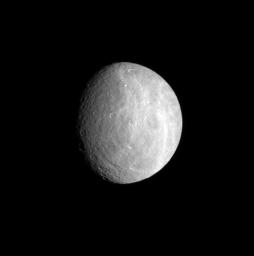
|
A Defining Feature
- Click the image above for a larger view
- Full-Res JPEG (446 x 450) (8.3 kB)
- Full-Res TIFF (446 x 450) (201.1 kB)
Caption:
Bright, wispy markings cover the trailing hemisphere of Rhea. The features are thought to be similar in nature to the bright, icy canyons seen on Dione (see PIA06162 ).
North on Rhea (1,528 kilometers, 949 miles across) is up and rotated 17 degrees to the left.
The image was taken in visible green light with the Cassini spacecraft narrow-angle camera on July 22, 2007. The view was acquired at a distance of approximately 1.2 million kilometers (700,000 miles) from Rhea and at a Sun-Rhea-spacecraft, or phase, angle of 42 degrees. Image scale is 7 kilometers (4 miles) per pixel.
Background Info:
The Cassini-Huygens mission is a cooperative project of NASA, the European Space Agency and the Italian Space Agency. The Jet Propulsion Laboratory, a division of the California Institute of Technology in Pasadena, manages the mission for NASA's Science Mission Directorate, Washington, D.C. The Cassini orbiter and its two onboard cameras were designed, developed and assembled at JPL. The imaging operations center is based at the Space Science Institute in Boulder, Colo.
For more information about the Cassini-Huygens mission visit http://saturn.jpl.nasa.gov/home/index.cfm . The Cassini imaging team homepage is at http://ciclops.org .
Cataloging Keywords:
| Name | Value | Additional Values |
|---|---|---|
| Target | Rhea | |
| System | Saturn | |
| Target Type | Satellite | |
| Mission | Cassini-Huygens | |
| Instrument Host | Cassini Orbiter | |
| Host Type | Orbiter | |
| Instrument | Imaging Science Subsystem (ISS) | |
| Detector | Narrow Angle Camera | |
| Extra Keywords | Grayscale, Rotation, Visual | |
| Acquisition Date | ||
| Release Date | 2007-09-11 | |
| Date in Caption | 2007-07-22 | |
| Image Credit | NASA/JPL/Space Science Institute | |
| Source | photojournal.jpl.nasa.gov/catalog/PIA09725 | |
| Identifier | PIA09725 | |
